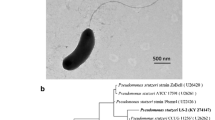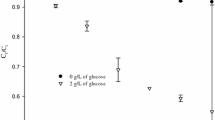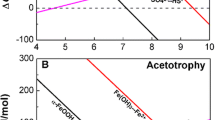Abstract
Shewanella putrefaciens is a species of metal-reducing bacteria with a versatile respiratory metabolism. This study reports that S. putrefaciens strain MR-1 rapidly reduces Fe(III) within smectite clay minerals. Up to 15% of the structural Fe within ferruginous smectite (sample SWa-1, Source Clays Repository of the Clay Minerals Society) was reduced by MR-1 in 4 h, and a range of 25% to 41% of structural Fe was reduced after 6 to 12 d during culture. Conditions for which smectite reduction was optimal, that is, pH 5 to 6, at 25 to 37 °C, are consistent with an enzymatic process and not with simple chemical reduction. Smectite reduction required viable cells, and was coupled to energy generation and carbon metabolism for MR-1 cultures with smectite added as the sole electron acceptor. Iron(III) reduction catalyzed by MR-1 was inhibited under aerobic conditions, and under anaerobic conditions it was inhibited by the addition of nitrate as an alternate electron acceptor or by the metabolic inhibitors tetrachlorosali-cylanilide (TCS) or quinacrine hydrochloride. Genetic mutants of MR-1 deficient in anaerobic respiration reduced significantly less structural Fe than wild-type cells. In a minimal medium with formate or lactate as the electron donor, more than three times the amount of smectite was reduced over no-carbon controls. These data point to at least one mechanism that may be responsible for the microbial reduction of clay minerals within soils, namely, anaerobic respiration, and indicate that pure cultures of MR-1 provide an effective model system for soil scientists and mineralogists interested in clay reduction. Given the ubiquitous distribution and versatile metabolism of MR-1, these studies may have further implications for bioremediation and water quality in soils and sediments.
Similar content being viewed by others
References
Amonette JE, Stucki JW, Khan F, Gan H, Scott AD. 1994. Quantitative oxidation state analysis of soils. In: Amonette JE, Zelazny LW, editors. Quantitative methods in soil mineralogy. Soil Sci Soc Am Miscellaneous Publication. Madison, WI: Soil Sci Soc Am p 83–113.
Arnold R, DiChristina T, Hoffman M. 1988. Reductive dissolution of Fe(III) oxides by Pseudomonas sp. 200. Bio-technol Bioeng 32:1081–1096.
Brettar I, Hoefle M. 1993. Nitrous oxide producing heterotrophic bacteria from the water column of the central Baltic: abundance and molecular identification. Mar Ecol Prog Ser 94:253–265.
Burdige DJ. 1993. The biogeochemistry of manganese and iron reduction in marine sediments. Earth Sci Rev 35:249–284.
Canfield DE, Thamdrup B, Hansen JW. 1993. The anaerobic degradation of organic matter in Danish coastal sediments: iron reduction, manganese reduction, and sulfate reduction. Geochim Cosmochim Acta 57:3867.
Chapelle FH, Lovley DR. 1992. Competitive exclusion of sulfate reduction by Fe3+-reducing bacteria: a mechanism for producing discrete zones of high-iron ground water. Ground Water 30:29–36.
Chen SA, Low PF, Roth CB. 1987. Relation between potassium fixation and the oxidation state of octahedral iron. Soil Sci Soc Am J 51:82–86.
Gate WP, Wilkinson HT, Stucki JW. 1993. Swelling properties of microbially reduced ferruginous smectite. Clays & Clay Miner 41:360–364.
Goodman BA, Russell JD, Fraser AR, Woodhams FWD. 1976. A Mössbauer and I.R. spectroscopic study of the structure of nontronite. Clays & Clay Miner 24:53–59.
Isphording WC. 1975. Primary nontronite from Venezuelan Guyana. Am Miner 60:840–848.
Jenne EA. 1977. Trace element sorption by sediments and soil sites and processes. In: Chappel W, Petersen K, editors. Symposium on molybdenum in the environment. New York: Marcel Dekker. p 425–453.
Keller MD, Bellows WK, Guillard RRL. 1988. Microwave treatment for sterilization of phytoplankton culture media. J Exp Mar Biol Fcol 117:279–283.
Komadel P, Stucki JW. 1988. Quantitative assay of minerals for Fe2+ and Fe3+ using 1,10-phenanthroline: III. A rapid photochemical method. Clays & Clay Miner 36:379–381.
Kostka JE, Luther GW, III. 1994. Partitioning and speciation of solid phase iron in saltmarsh sediments. Geochim Cosmochim Acta 58:1701–1710.
Kostka JE, Luther GW, III., Nealson KH. 1995. Chemical and biological reduction of Mn3+-pyrophosphate complexes: potential importance of dissolved Mn’+ as an environmental oxidant. Geochim Cosmochim Acta 59:885–894.
Kostka JE, Nealson KH. 1995. Dissolution and reduction of magnetite by bacteria. Environ Sci Technol 29:2535–2540.
Lamb CA, Grady RI. 1963. A study of soil heaving with frost. Ohio Farm & Home Res 48:43–47.
Lear PR, Stucki JW. 1989. Effects of iron oxidation state on the specific surface area of nontronite. Clays & Clay Miner 37:547–552.
Lovley DR. 1991. Dissimilatory Fe3+ and Mn4+ reduction. Microbiol Rev 55:259–287.
Lovley DR. 1993a. Anaerobes into heavy metal: dissimilatory metal reduction in anoxic environments. Trends in Ecol & Evol 8:213–217.
Lovley DR. 1993b. Dissimilatory metal reduction. Ann Rev Microbiol 47:263–290.
Lovley DR, Chapelle FH, Phillips EJP. 1990. Fe(III) reducing bacteria in deeply buried sediments of the Atlantic Coastal Plain. Geology 18:954–957.
Myers CR, Myers JM. 1992. Localization of cytochromes to the outer membrane of anaerobically grown Shewanella pu-trefaciens MR-1. J Bacteriol 174:3429–3438.
Myers CR, Nealson KH. 1988. Bacterial manganese reduction and growth with manganese oxide as the sole electron acceptor. Science 240:1319–1321.
Nealson KH, Myers CR. 1992. Microbial reduction of manganese and iron: new approaches to carbon cycling. Appl Environ Microbiol 58:439–443.
Nealson KH, Saffarini DA. 1994. Iron and manganese in anaerobic respiration: environmental significance, physiology, and regulation. Ann Rev Microbiol 48:311–343.
Nealson KH, Myers CR, Wimpee BB. 1991. Isolation and identification of manganese-reducing bacteria and estimates of microbial Mn(IV)-reducing potential in the Black Sea. Deep-Sea Res 38:S907–S920.
Nealson KH, Saffarini DA, Moser D. 1995. Anaerobic respiration of Shewanella putrefaciens: potential use of solid electron acceptors for pollutant removal and bioremediation in anoxic environments. In: DeLuca M, editor. Bioremediation of Contaminants in Soils and Sediments. New Brunswick, NJ: Rutgers University Press (In press.)
Obuekwe C, Westlake DW. 1982. Effects of medium composition on cell pigmentation, cytochrome content, and ferric iron reduction in a Pseudomonas sp. isolated from crude oil. Can J Microbiol 28:989–992.
Petrovskis EA, Vogel TM, Adriaens P. 1994. Effects of electron acceptors and donors on transformation of tetrachlo-romethane by Shewanella putrefaciens MR-1. FEMS Microbiol Lett 121:357–364.
Ponnamperuma FN, Tianco EM, Loy T. 1967. Redox equilibria in flooded soils: 1. The iron hydroxide systems. Soil Sci 103:374–382.
Saffarini DA, DiChristina TJ, Bermudes D, Nealson KH. 1994. Anaerobic respiration of Shewanella putrefaciens requires both chromosomal and plasmid-borne genes. FEMS Microbio Lett 119:271–278.
Schlautman MA, Morgan JJ. 1994. Sorption of perylene on a nonporous inorganic silica surface: effects of aqueous chemistry on sorption rates. Environ Sci Technol 28:2184–2190.
Scott JH, Nealson KH. 1994. Anaerobic methylotrophy in a facultative anaerobe: Shewanella. J Bacteriol 176:3408–3411.
Shen S, Stucki JW. 1994. Effects of iron oxidation state on the fate and behavior of potassium in soils. In: Havlin JL, Jacobsen J, Fixen P, Hergert G, editors. Soil testing: Prospects for improving nutrient recommendations. SSSA Special Publication 40. Madison, WI: Soil Sci Soc Am p 173–185.
Stookey LL. 1970. Ferrozine-a new spectrophotometric reagent for iron. Anal Chem 42:779–781.
Stucki JW. 1981. The quantitative assay of minerals for Fe3+ and Fe3+ using 1,10-phenanthroline: II. A photochemical method. Soil Sci Soc Am J 45:638–641.
Stucki JW. 1988. Structural iron in smectites. In: Stucki JW, Goodman BA, Schwertmann U, editors. Iron in soils and clay minerals. Dordrecht, The Netherlands: D. Reidel p 625–675.
Stucki JW, Lear PR. 1990. Variable oxidation states of iron in the crystal structure of smectite clay minerals. In: Coyne LM, Blake D, McKeever S, editors. Structures and active sites of minerals. Washington, D.C.: Am Chem Soc p 330–358.
Stucki JW, Tessier D. 1991. Effects of iron oxidation state on the texture and structural order of Na-nontronite gels. Clays & Clay Miner 39:137–143.
Stucki JW, Golden DC, Roth CB. 1984a. Preparation and handling of dithionite reduced smectite suspensions. Clays & Clay Miner 32:191–197.
Stucki JW, Low PF, Roth CB, Golden DC. 1984b. Effect of iron oxidation state on clay swelling. Clays & Clay Miner 32:357–362.
Stucki JW, Komadel P, Wilkinson HT. 1987. Microbial reduction of structural Fe3+ in smectites. Soil Sci Soc Am J 51:1663–1665.
Wu J, Roth CB, Low PF. 1988. Biological reduction of structural Fe in sodium-nontronite. Soil Sci Soc Am J 52:295–296.
Author information
Authors and Affiliations
Corresponding author
Rights and permissions
About this article
Cite this article
Kostka, J.E., Stucki, J.W., Nealson, K.H. et al. Reduction of Structural Fe(III) in Smectite by a Pure Culture of Shewanella Putrefaciens Strain MR-1. Clays Clay Miner. 44, 522–529 (1996). https://doi.org/10.1346/CCMN.1996.0440411
Received:
Accepted:
Published:
Issue Date:
DOI: https://doi.org/10.1346/CCMN.1996.0440411




